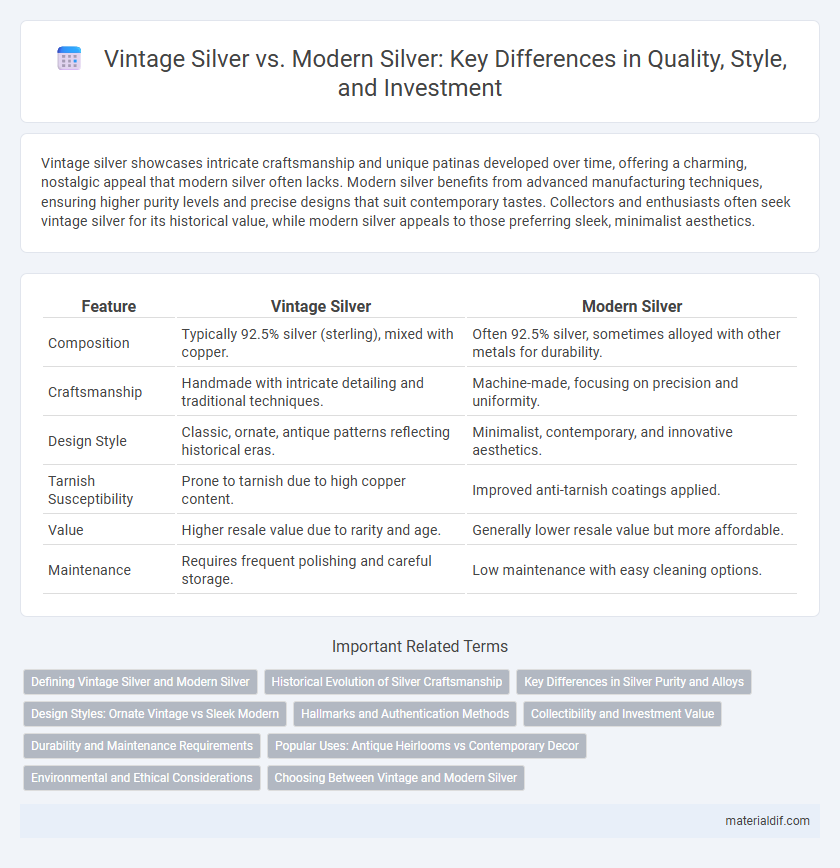Vintage silver showcases intricate craftsmanship and unique patinas developed over time, offering a charming, nostalgic appeal that modern silver often lacks. Modern silver benefits from advanced manufacturing techniques, ensuring higher purity levels and precise designs that suit contemporary tastes. Collectors and enthusiasts often seek vintage silver for its historical value, while modern silver appeals to those preferring sleek, minimalist aesthetics.
Table of Comparison
| Feature | Vintage Silver | Modern Silver |
|---|---|---|
| Composition | Typically 92.5% silver (sterling), mixed with copper. | Often 92.5% silver, sometimes alloyed with other metals for durability. |
| Craftsmanship | Handmade with intricate detailing and traditional techniques. | Machine-made, focusing on precision and uniformity. |
| Design Style | Classic, ornate, antique patterns reflecting historical eras. | Minimalist, contemporary, and innovative aesthetics. |
| Tarnish Susceptibility | Prone to tarnish due to high copper content. | Improved anti-tarnish coatings applied. |
| Value | Higher resale value due to rarity and age. | Generally lower resale value but more affordable. |
| Maintenance | Requires frequent polishing and careful storage. | Low maintenance with easy cleaning options. |
Defining Vintage Silver and Modern Silver
Vintage silver refers to silver items crafted typically before the 1950s, characterized by traditional craftsmanship, hallmarks, and a patina developed over decades. Modern silver encompasses pieces produced from the mid-20th century to the present, often featuring contemporary designs, advanced manufacturing techniques, and higher purity standards like sterling silver (.925 fineness). Collectors value vintage silver for its historical significance and uniqueness, while modern silver is prized for durability and stylistic versatility.
Historical Evolution of Silver Craftsmanship
Vintage silver reflects centuries of meticulous craftsmanship, showcasing intricate hand-engraving and traditional techniques passed down through generations since the 18th century. Modern silver emphasizes precision and innovation, often incorporating advanced manufacturing methods like electroplating and laser engraving introduced in the late 20th century. The historical evolution of silver craftsmanship reveals a shift from purely artisanal production to a blend of artistic heritage and cutting-edge technology.
Key Differences in Silver Purity and Alloys
Vintage silver typically contains higher silver purity levels, often ranging from 90% to 92.5%, commonly seen in sterling silver pieces. Modern silver alloys may incorporate additional metals such as copper, nickel, or zinc to enhance durability and reduce tarnishing, sometimes balancing purity with practicality. The variation in alloy composition affects not only the silver content but also the item's color, strength, and maintenance requirements.
Design Styles: Ornate Vintage vs Sleek Modern
Vintage silver is characterized by intricate, ornate designs featuring detailed engravings, filigree, and classical motifs that reflect historical craftsmanship and artistic traditions. Modern silver emphasizes sleek, minimalistic aesthetics with smooth surfaces, geometric shapes, and clean lines, appealing to contemporary tastes and functionality. The contrast between vintage and modern silver highlights the evolution of design styles from elaborate decorative elements to streamlined simplicity.
Hallmarks and Authentication Methods
Vintage silver often features traditional hallmarks such as the lion passant, maker's marks, and date letters that provide detailed information about origin and authenticity. Modern silver incorporates more standardized and sometimes laser-engraved hallmarks, along with advanced authentication methods like X-ray fluorescence (XRF) analysis for precise alloy composition verification. Collectors and buyers rely on these hallmark details and scientific testing to distinguish genuine vintage pieces from contemporary reproductions.
Collectibility and Investment Value
Vintage silver, often characterized by unique craftsmanship and historical significance, tends to have higher collectibility due to its rarity and patina that appeals to collectors. Modern silver items, while typically more standardized and readily available, offer consistent purity and may attract investors looking for liquidity and predictable market values. The investment value of vintage silver largely depends on provenance and condition, whereas modern silver's value primarily relies on current silver spot prices and demand.
Durability and Maintenance Requirements
Vintage silver often exhibits greater durability due to higher purity levels and traditional crafting methods, making it more resistant to damage and wear over time. Modern silver, typically alloyed with more durable metals like copper or nickel, may offer improved scratch resistance but requires regular polishing to prevent tarnish. Maintenance of vintage silver involves careful cleaning to preserve patina, while modern silver benefits from routine upkeep using commercial silver polishes and protective coatings to maintain its shine.
Popular Uses: Antique Heirlooms vs Contemporary Decor
Vintage silver is often cherished for its intricate craftsmanship and historical value, making it highly sought after as antique heirlooms passed down through generations. Modern silver, characterized by sleek designs and minimalist aesthetics, is predominantly used in contemporary decor and everyday tableware. Collectors and interior designers value vintage silver for its uniqueness, while modern silver appeals to those seeking functional elegance in home accents.
Environmental and Ethical Considerations
Vintage silver often carries a lower environmental footprint due to recycling and reduced demand for newly mined silver, which involves energy-intensive extraction and toxic chemical use. Modern silver production increasingly adopts ethical sourcing standards and sustainable mining practices to address concerns about labor conditions and ecological impact. Consumers seeking environmentally friendly and ethically sourced silver can prioritize hallmark certifications and provenance documentation to ensure responsible supply chains.
Choosing Between Vintage and Modern Silver
Choosing between vintage silver and modern silver depends on factors like craftsmanship, design, and silver content. Vintage silver often features intricate handwork and higher silver purity, such as sterling silver (.925), valued for its historical significance and patina development. Modern silver typically offers contemporary designs with consistent alloy compositions and may include additional protective coatings for durability and tarnish resistance.
Vintage Silver vs Modern Silver Infographic

 materialdif.com
materialdif.com